Planning the Day with Object Calendars
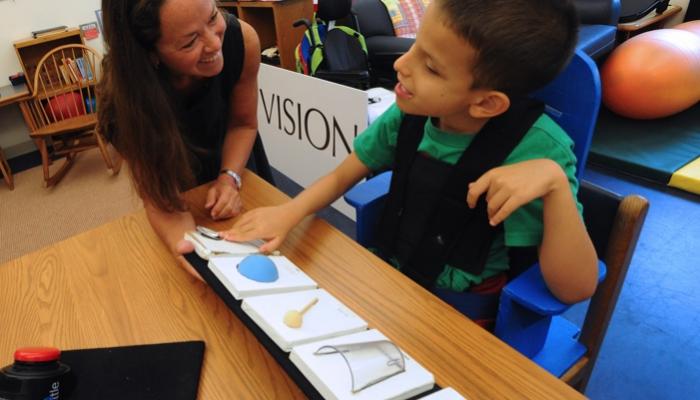
This post may contain affiliate links; please see our terms of use for details.
So your child is out of school for a one week or (gasp) maybe even a five week vacation.
I know you love your little one and you love the family time you get to share with him, but during vacation times there is a sudden lack of routine and activities fluctuate.
If your child is anything like mine this is a recipe for disaster. Vacation seems to be the perfect time to forget self feeding skills, go backwards with toilet training, and learn that screaming is the best way to get what you want. Ugh.
Why is this? And how can we address it?
The loss of an organized routine can be very disorienting for a child with a vision impairment. If you can’t see, it can be difficult to figure out what’s happening and what to expect, but with a good routine our kids can rely on structure to get through their day.
Loose the structure and suddenly transitioning from one activity to the next can be very, very difficult. If your child also has trouble communicating, this can become even more disorienting and frustrating.
Creating a plan and a tangible system of communication is the best way to deal with this. And that’s where Object Calendars come in. If you can create an object calendar or a schedule box you can help ease your child’s discomfort and get through those challenging days when you have no real routine. If you start using a system now, it’ll be even easier to continue its use through summer or winter vacations when you’ll need it most!
What is an Object Calendar?
Object calendars come in many shapes, sizes, and names. They can be called schedule or calendar boxes or tangible symbol systems.
What they all have in common is that they are a simple system, usually using tactile symbols, that tell your child what he is doing now, when an activity is finished, and what to expect next. It’s easy to make one for your own child and also super easy to adapt to your child’s specific needs.
Why use an Object Calendar?
 Object calendars ease transitions and anxiety by letting your child know what is happening and what to expect. They can also create anticipation. If something fun will be happening later in the day your child has the opportunity to get excited about it.
Object calendars ease transitions and anxiety by letting your child know what is happening and what to expect. They can also create anticipation. If something fun will be happening later in the day your child has the opportunity to get excited about it.
Getting your child involved in putting the calendar together in the morning gives her control over her day and develops a sense of autonomy. This also means that changes in routine will be less scary because she will know they are going to happen and participated in planning for it.
Object calendars also build in a series of systematic steps to every activity (finding the symbol, talking about the symbol, placing the symbol in the “all done box,” etc) so that transitioning is slower and easier to manage.
Calendar systems are also great ways to boost communication skills. You can talk about what’s happening now, what you’ve done in the past, and what you’re going to do in the future. These are all very important time concepts as well as communication boosters.
Creating your Object Calendar
Object calendars are very adaptable. What are your goals for you child? Do you want them to make choices, reject options, discuss activities, or simply be aware of what’s happening and feel like they are a part of the decision-making process?
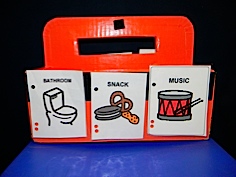 And what are your child’s skills? What kind of vision does he or she have? You can add large print or braille to your symbols or work with high contrast colors. If your child is completely blind, you’ll want to focus on very tactual symbols. If your child has quite a bit if useable vision, you may want to use large colored images instead.
And what are your child’s skills? What kind of vision does he or she have? You can add large print or braille to your symbols or work with high contrast colors. If your child is completely blind, you’ll want to focus on very tactual symbols. If your child has quite a bit if useable vision, you may want to use large colored images instead.
You’ll also need to develop a set routine, whether your child is in school or on vacation, so you can create symbols that you can use every day. Some basics to start with would be a toilet symbol, a tooth brush symbol, a meal time symbol, and a bedtime symbol.
To make the symbols, begin with a large piece of foam board and cut it into 4×6 inch pieces. Attach familiar objects related to each activity directly to the foam board pieces with glue (a glue gun works well for this). You can add braille or large print directly to the board, too.
Using the foam board gives each symbol a similar and distinct “symbol” feel, but if you want to work with just a set of objects (that aren’t glued to boards), you can do that too.
Choosing your objects can be tricky. You want to pick things that will be easily associated with a specific activity and not confused with a different activity. For example, when we were creating a bath time symbol, we bought two identical rubber duckies. One went in the bath and one went on a board, so that it was obvious that this was the bath time symbol. We don’t play with those duckies outside of the bath so the symbol remains clear.
Next, you’ll need a box to place your symbols on. Velcro tape is a perfect way to attach your symbols to your box so you can rearrange them and reuse them every day. A plastic utility caddy works well as a calendar box. Simply adhere a strip of velcro along the top of the caddy and attach your symbols to the outside of the caddy. As you complete an activity, throw the symbol into the caddy and it’s “all done!”
Using your Object Calendar
Again, since object calendars are extremely adaptable to your child’s needs, you can decide the best way to use them. Here’s a typical way to use an object calendar, but you can make changes where appropriate for your family and your child’s abilities:
- In the morning, pull out your bin full of symbols and have your child help you adhere the symbols for the day to their box. Talk about what you will be doing and in what order.
- Begin with the first symbol, maybe meal time represented by a fork glued to the board, and help your child take the symbol off the box and feel it. Feel the braille and talk about what it says. Talk about what you’ll be eating for breakfast. Put the symbol back on the box and move from the symbol to the activity fairly quickly so the meaning is clear.
- After breakfast take the symbol off again and talk about how breakfast is over. Place the symbol in the caddy’s box (we call it the “all done box”) and explain that breakfast is all done. Pick up the next symbol, maybe a tooth brush on a board, and talk about what you’re going to do next (brush teeth and wash up). Again, move fairly quickly to the next activity so your child connects the meaning.
- Continue throughout the day. Talk about the symbols and help your child remove them, touch them, and put them away. As you get used to using the symbols it’ll become an important part of your day and will help organize activities. Using a small portable box like the caddy helps because it’ll be easy to take with you when you go out.
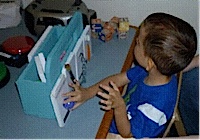 Don’t feel that you have to follow the above scenario exactly. Play with the symbols, maybe starting with just three or four for the day, and see how your child responds. Maybe she does best with symbols for games so you might want to just focus on blocks or ball symbols.
Don’t feel that you have to follow the above scenario exactly. Play with the symbols, maybe starting with just three or four for the day, and see how your child responds. Maybe she does best with symbols for games so you might want to just focus on blocks or ball symbols.
If you like the idea of encouraging choice then you’ll want to have two symbols to present to your child at a time. Would you rather go to the park and swing or stay home and have a snack? Letting your child choose can be really rewarding.
If your child has enough usable vision, using large print colorful images works well. You can even tuck the images into a small photo book with slide-in pockets creating a calendar book instead of a box.
Experiment with your system and find one that works for you and your child. See if you can get your teachers at school to use a similar system for continuity. This will make that time away from school even easier!
More Resources
- Let Me Check My Calendar: A basic overview of object calendars, how to use them, and more complex calendar systems.
- Activity Calendars: For some kids having a daily calendar that shows them everything they will be doing that day may be overwhelming. In this article you can learn about creating an activity calendar that just includes symbols for one activity.
- Beginning to Use an Object Calendar: Tips on how to introduce object calendars to blind students and how to make it fun!
- Directory of Standard Tactile Symbols: If you want to get serious about using tactile symbols then you’ll want to learn about the standard and universal symbols. There are standard symbols for the days of the week, months of the year, yes and no, and a lot more.
- A Standard Tactile Symbol System: Graphic Language for Individuals who are Blind and Unable to Learn Braille: Tips on using the standard tactile symbol systems.
- Tangible Symbols Webcast: Speech and language pathologist, Elizabeth Torrey, explains what tangible symbols are and how to use them in this webcast from Perkins.
- Communication Systems: This article shows how students at the Perkins School for the Blind use many different systems, including object calendars, to aid in communication.
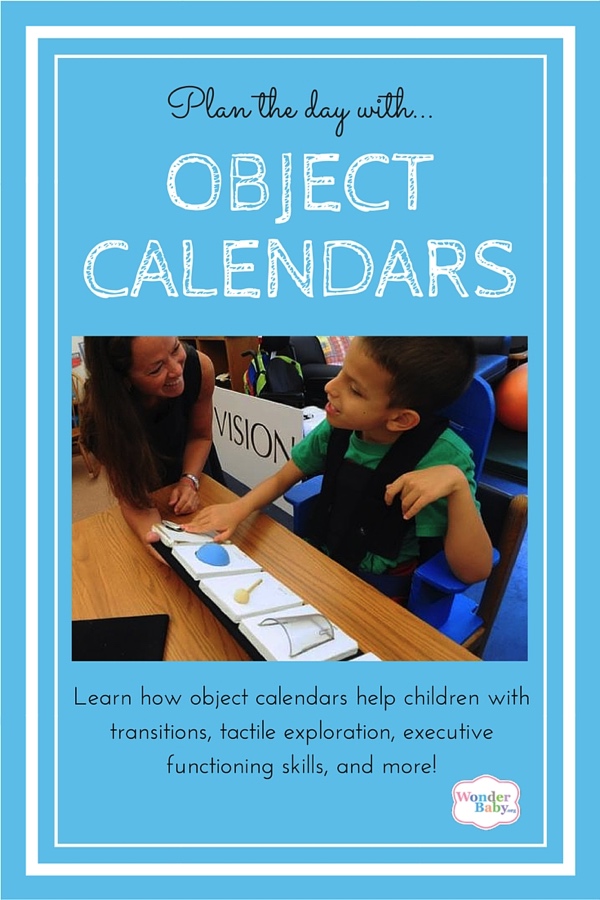
Related Posts

Communication, Health & Nutrition
Recurrent Ear Infections and Their Impact on Speech/Language Development
Learn more about the relationship between recurrent ear infections and their potential effect on speech and language development.

Communication, Potty Training
How to Use Sign Language for Potty Training
Sign language can be helpful for potty training young children who are pre-verbal, kids with special needs, or for multilingual families.
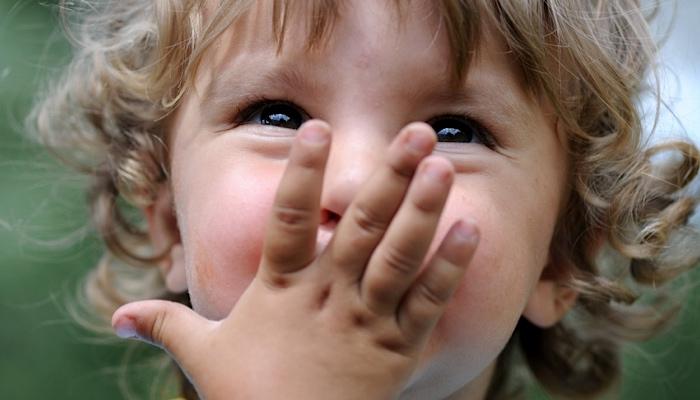
Communication, Visual Impairment
Teaching Your Visually Impaired Child Sign Language
Jennie writes about how she taught her son, Max, to sign. Max is totally blind and does have a few verbal words, but using signs to augment his early communication...